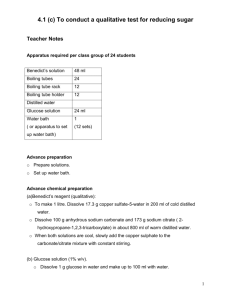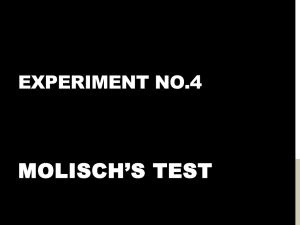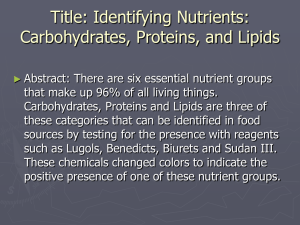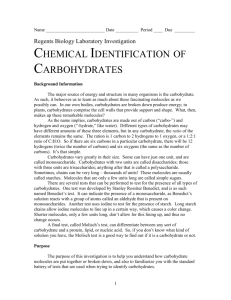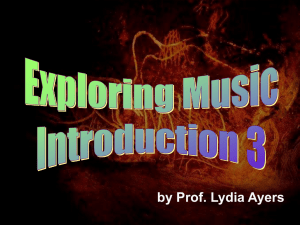Experiment 4 – Carbohydrate Characterization
advertisement
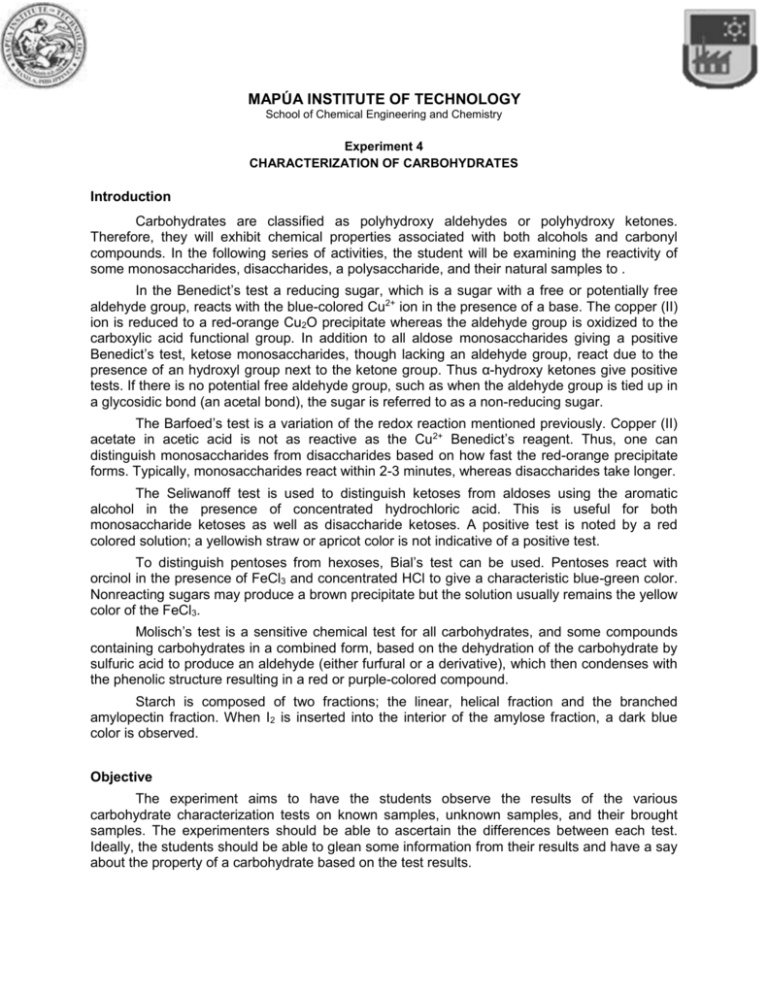
MAPÚA INSTITUTE OF TECHNOLOGY School of Chemical Engineering and Chemistry Experiment 4 CHARACTERIZATION OF CARBOHYDRATES Introduction Carbohydrates are classified as polyhydroxy aldehydes or polyhydroxy ketones. Therefore, they will exhibit chemical properties associated with both alcohols and carbonyl compounds. In the following series of activities, the student will be examining the reactivity of some monosaccharides, disaccharides, a polysaccharide, and their natural samples to . In the Benedict’s test a reducing sugar, which is a sugar with a free or potentially free aldehyde group, reacts with the blue-colored Cu2+ ion in the presence of a base. The copper (II) ion is reduced to a red-orange Cu2O precipitate whereas the aldehyde group is oxidized to the carboxylic acid functional group. In addition to all aldose monosaccharides giving a positive Benedict’s test, ketose monosaccharides, though lacking an aldehyde group, react due to the presence of an hydroxyl group next to the ketone group. Thus α-hydroxy ketones give positive tests. If there is no potential free aldehyde group, such as when the aldehyde group is tied up in a glycosidic bond (an acetal bond), the sugar is referred to as a non-reducing sugar. The Barfoed’s test is a variation of the redox reaction mentioned previously. Copper (II) acetate in acetic acid is not as reactive as the Cu2+ Benedict’s reagent. Thus, one can distinguish monosaccharides from disaccharides based on how fast the red-orange precipitate forms. Typically, monosaccharides react within 2-3 minutes, whereas disaccharides take longer. The Seliwanoff test is used to distinguish ketoses from aldoses using the aromatic alcohol in the presence of concentrated hydrochloric acid. This is useful for both monosaccharide ketoses as well as disaccharide ketoses. A positive test is noted by a red colored solution; a yellowish straw or apricot color is not indicative of a positive test. To distinguish pentoses from hexoses, Bial’s test can be used. Pentoses react with orcinol in the presence of FeCl3 and concentrated HCl to give a characteristic blue-green color. Nonreacting sugars may produce a brown precipitate but the solution usually remains the yellow color of the FeCl3. Molisch’s test is a sensitive chemical test for all carbohydrates, and some compounds containing carbohydrates in a combined form, based on the dehydration of the carbohydrate by sulfuric acid to produce an aldehyde (either furfural or a derivative), which then condenses with the phenolic structure resulting in a red or purple-colored compound. Starch is composed of two fractions; the linear, helical fraction and the branched amylopectin fraction. When I2 is inserted into the interior of the amylose fraction, a dark blue color is observed. Objective The experiment aims to have the students observe the results of the various carbohydrate characterization tests on known samples, unknown samples, and their brought samples. The experimenters should be able to ascertain the differences between each test. Ideally, the students should be able to glean some information from their results and have a say about the property of a carbohydrate based on the test results. Materials and Methods Carbohydrate test solutions 5% solutions of glucose, galactose, fructose, maltose, lactose, sucrose, and starch An unknown sample for the class Kamote and potato samples Test reagents *The “test carbohydrate solution” indicated in the steps below refers to the known carbohydrate solutions, your unknown sample, and your kamote, potato, and rice samples. Sample Preparation 1. The known and unknown samples are already prepared, so don’t worry about that. 2. For your kamote, potato, and rice samples, take a piece of each and grind separately in a mortar and pestle along with roughly 15-20 ml of water. 3. After grinding thoroughly, filter when you think you have produced a liquidy, sopas-like extract or solution. Save the filtrate and use it as part of the carbohydrate test solutions. Of course, label it appropriately. Benedict’s Test 1. Prepare a boiling water bath and label eight clean small test tubes. 2. In separate test tubes add 1 mL of the Benedict’s reagent. To each test tube add 5 drops of the test carbohydrate solution. Mix the samples. 3. Place all of the test tubes at the same time into the boiling water bath. 4. Note and record how long it takes for the red Cu2O precipitate to form; also note if the blue Benedict’s reagent color disappears. 5. After 10 minutes remove all the tubes. Keep the boiling water bath going for the remaining three experiments. Did any sugars not produce the red precipitate? Which are reducing sugars? Which are not? Barfoed’s Test 1. Use the boiling water bath from before and label a new set of 8 clean small test tubes. 2. In separate test tubes add 1 mL of the Barfoeds’s reagent. To each test tube add 10 drops of the test carbohydrate solution. Mix the samples. 3. Place all of the test tubes at the same time into the boiling water bath. 4. Note and record how long it takes for the red Cu2O precipitate to form. 5. After 10 minutes remove all the tubes. Based on your results which are monosaccharides? Which are disaccharides? Seliwanoff Test 1. Use the boiling water bath from before and label a new set of 8 clean small test tubes. 2. In separate test tubes add 1 mL of the Seliwanoff’s reagent. To each test tube add 3 drops of the test carbohydrate solution. Mix the samples. 3. Place all of the test tubes at the same time into the boiling water bath. 4. Note and record how long it takes for the first clear red colored solution to form. 5. Remove all the tubes as soon as the first positive test is seen as prolonged heating (in excess of 5 minutes) may cause spurious results. Which sugar solution(s) contain a ketose? Bial’s Test 1. Use the boiling water bath from before and label a new set of clean small test tubes 2. In separate test tubes add 1 mL of the Bial’s reagent. To each test tube add 10 drops of the test carbohydrate solution. Mix the samples. 3. Place all of the test tubes at the same time into the boiling water bath. 4. Note and record how long it takes for the first clear blue-green solution to form. 5. Remove all the tubes as soon as the first positive test is seen as prolonged heating may cause spurious results. Which sugar solution(s) contain a pentose? Molisch’s Test 1. Place 2 mL of a known carbohydrate solution in a test tube, add 1 drop of Molisch’s reagent (10% α-naphthol in ethanol). 2. Pour 1-2 mL of conc. H2SO4 down the side of the test tube, so that it forms a layer at the bottom of the tube. 3. Observe the color at the interface between two layers and compare your result with a control test. *A brown color due to charring must be ignored and the test should be repeated with a more dilute sugar solution. Iodine test 1. Place 3 drops of each test carbohydrate solution in separate wells of a clean spot plate. 2. Add 1 drop of the iodine solution to each test carbohydrate solution. 3. Note and record the color of each sample. 4. Did any other solutions besides the starch solution give a positive test? Some points to consider Create a table detailing the differences between the tests, especially the differences in what they detect or what they test for Create a data table before doing the experiment. Get organized!
